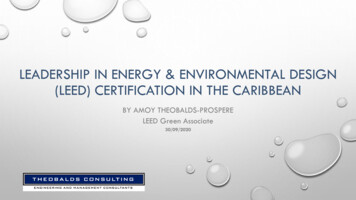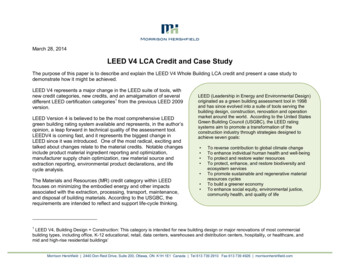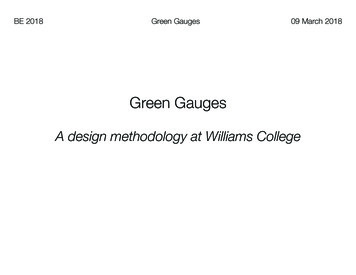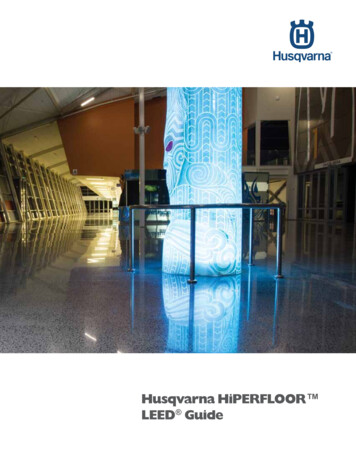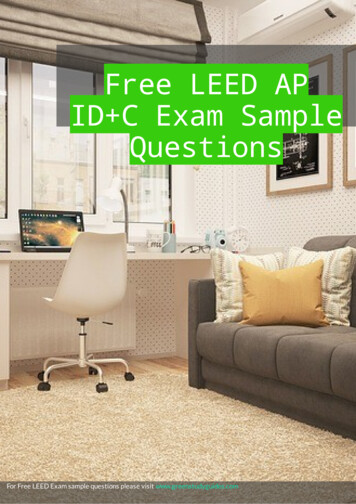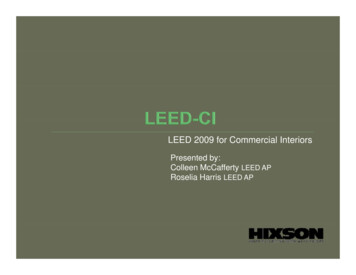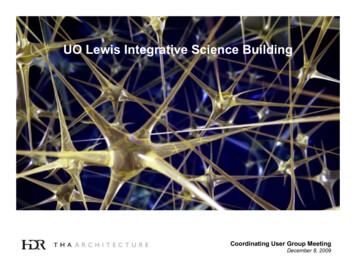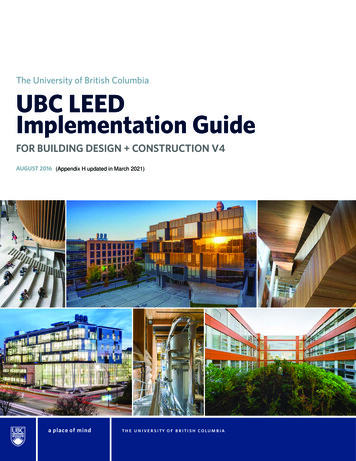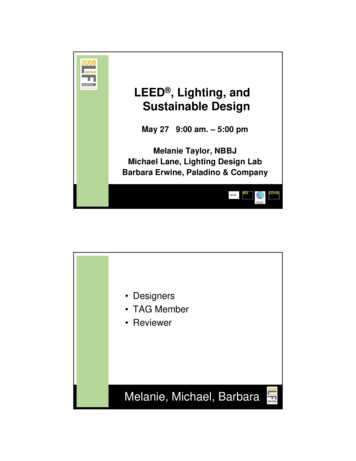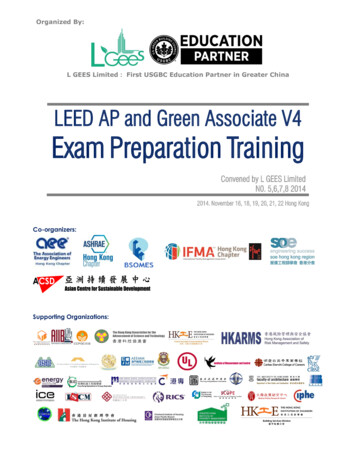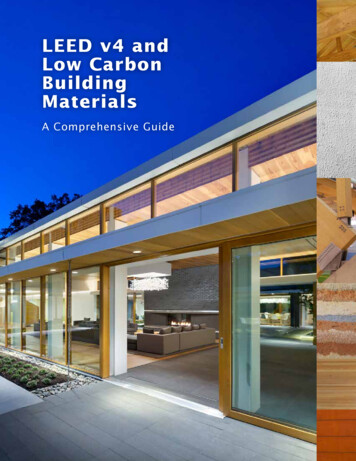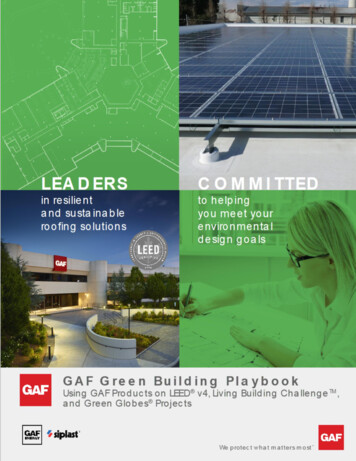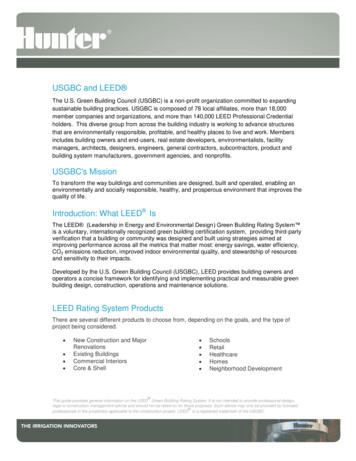
Transcription
USGBC and LEED The U.S. Green Building Council (USGBC) is a non-profit organization committed to expandingsustainable building practices. USGBC is composed of 78 local affiliates, more than 18,000member companies and organizations, and more than 140,000 LEED Professional Credentialholders. This diverse group from across the building industry is working to advance structuresthat are environmentally responsible, profitable, and healthy places to live and work. Membersincludes building owners and end-users, real estate developers, environmentalists, facilitymanagers, architects, designers, engineers, general contractors, subcontractors, product andbuilding system manufacturers, government agencies, and nonprofits.USGBC's MissionTo transform the way buildings and communities are designed, built and operated, enabling anenvironmentally and socially responsible, healthy, and prosperous environment that improves thequality of life.Introduction: What LEED IsThe LEED (Leadership in Energy and Environmental Design) Green Building Rating System is a voluntary, internationally recognized green building certification system, providing third-partyverification that a building or community was designed and built using strategies aimed atimproving performance across all the metrics that matter most: energy savings, water efficiency,CO2 emissions reduction, improved indoor environmental quality, and stewardship of resourcesand sensitivity to their impacts.Developed by the U.S. Green Building Council (USGBC), LEED provides building owners andoperators a concise framework for identifying and implementing practical and measurable greenbuilding design, construction, operations and maintenance solutions.LEED Rating System ProductsThere are several different products to choose from, depending on the goals, and the type ofproject being considered. New Construction and MajorRenovationsExisting BuildingsCommercial InteriorsCore & Shell SchoolsRetailHealthcareHomesNeighborhood DevelopmentThis guide provides general information on the LEED Green Building Rating System. It is not intended to provide professional design,legal or construction management advice and should not be relied on for those purposes. Such advice may only be provided by licensed professionals in the jurisdiction applicable to the construction project. LEED is a registered trademark of the USGBC.
LEED 2009 New ConstructionLEED rating systems can be applied to any building type and any building lifecycle phase. Theypromote a whole-building approach to sustainability by recognizing performance in key areas.There are different product categories to consider meeting the project requirements, and irrigationproducts contribute similarly to most of them. This document will look specifically at the NewConstruction and Major Renovations rating system.The rating system is organized into five environmental categories:1.2.3.4.5.Sustainable SitesWater EfficiencyEnergy & AtmosphereMaterials & ResourcesIndoor Environmental QualityThere are also two other key performance areas:1. Innovation in Design2. Regional PriorityEach of the categories has a certain number of points available as follows:CategoryPointsSustainable SitesWater EfficiencyEnergy & AtmosphereMaterials & ResourcesIndoor Environmental QualityInnovation in DesignRegional PriorityTotal Points Available261035141564110There are four different levels of certification available, based on the goals of the project, and thenumber of points the project earns: Certified (40 Points)Silver (50 Points)Gold (60 Points)Platinum (80 Points)More information on the rating systems, the process, how to get started, and how to achievecertification are available at the USGBC website: www.usgbc.org. This guide provides general information on the LEED Green Building Rating System. It is not intended to provide professional design,legal or construction management advice and should not be relied on for those purposes. Such advice may only be provided by licensed professionals in the jurisdiction applicable to the construction project. LEED is a registered trademark of the USGBC.
Hunter Irrigation Products and LEEDHunter supports the overall goals of LEED and strives to provide the irrigation industry with themost water efficient products. We manufacture a variety of irrigation components that can helpdesigners, and owners earn LEED credits for their projects. The LEED system does not certifyindividual products; however, the selection of products plays an essential role in making abuilding project meet the requirements to earn points. Hunter’s High efficiency landscapeirrigation products can contribute to the earning of points for the following Credits in the LEED forNew Construction system: Water Efficiency Credit 1 (2 Options)Innovation in Design Credit 1Sustainable Sites Credit 5.1Sustainable Sites Credit 6.1Sustainable Sites Credit 7.2Energy & Atmosphere Credit 1There are 10 total points available in the Water Efficiency (WE) category, of which 4 points canbe earned in Credit 1 if both Options are met by making efficient landscape and irrigationdecisions. Irrigation may also effect the 5 other Credits listed above.Water Efficiency CreditCredit TitleWE 1 Option 1Water Efficient Landscaping:Reduce water use by 50%WE 1 Option 2Water Efficient Landscaping:No Potable Water Use or IrrigationBuildings are major users of our potable water supply. The goal of the Water Efficiency creditcategory is to encourage smarter use of water, inside and out. Water reduction is typicallyachieved through more efficient appliances, fixtures and fittings inside and water-wiselandscaping outside.Hunter’s high-efficiency irrigation products can aid the designer in producing an efficient irrigationsystem that can use less water and help to meet the requirements to earn the points for theWater Efficiency category. All documentation and narratives must follow the procedures set forthby the USGBC, to be considered for point awards. The USGBC website (www.usgbc.org) is thebest resource to find forms, and documentation for successful submittals, and certification. This guide provides general information on the LEED Green Building Rating System. It is not intended to provide professional design,legal or construction management advice and should not be relied on for those purposes. Such advice may only be provided by licensed professionals in the jurisdiction applicable to the construction project. LEED is a registered trademark of the USGBC.
Water Efficiency Credit 1 (WE 1):Water Efficient Landscaping---Option 1. Reduce by 50% (2 Points)IntentTo limit or eliminate the use of potable water, or other natural surface or subsurface waterresources available on or near the project site, for landscape irrigation.RequirementsReduce potable water consumption for irrigation by 50% from a calculated mid-summer baselinecase.Reductions shall be attributed to any combination of the following items: Plant species factorIrrigation efficiencyUse of captured rainwaterUse of recycled wastewaterUse of water treated and conveyed by a public agency specifically for non-potable usesPotential Technologies & StrategiesPerform a soil/climate analysis to determine appropriated plant material and design the landscapewith native or adapted plants to reduce or eliminate irrigation requirements. Where irrigation isrequired, use high-efficiency equipment and/or climate-based controllers.CalculationsTo calculate the percent reduction in potable use for this credit, establish a baseline water userate for your project, which represents a “typical” landscape that could be found on a similarproject in the area. Then, calculate the as-designed water use rate for the project. To completethese calculations, you will need to know the landscape coefficients for the major vegetationtypes, and the area of each.All calculations must be based on irrigation during the month with the highest evapotranspiration(ET) rate. Local ETo values are available from the EPA’s WaterSense website.You will also need to document the Irrigation Efficiency (IE) for each landscape area, based onthe type of irrigation used. Standard numbers for Sprinkler and Drip are given in the LEEDreference guide, and should be used to calculate the baseline case water use. This guide provides general information on the LEED Green Building Rating System. It is not intended to provide professional design,legal or construction management advice and should not be relied on for those purposes. Such advice may only be provided by licensed professionals in the jurisdiction applicable to the construction project. LEED is a registered trademark of the USGBC.
Water Efficiency Credit 1Calculations (continued)Irrigation Efficiency for the Design case may use different numbers than in the Baseline casebased on the efficiency numbers of the products selected for the irrigation plan.Controller Efficiency (CE) is another number that may have to be determined, and is defined asthe percent reduction in water use from any weather-based controllers or moisture sensor-basedsystems. It is equal to 1 minus the estimated percentage of overall irrigation water saved by thecontroller (CE 1 - % Savings). As an example, if a Hunter I-Core Controller is installed on aproject with a Hunter Solar Sync ET Sensor, and the estimated water savings is 20%, the CEwould be 0.8 (CE 1 – 0.2 0.8).Since there are a number of variables that influence the savings percentage one might expect,Hunter has developed a spreadsheet that can aid the designer in estimating the potential savings,and therefore the CE number required in the calculations. This spreadsheet looks at the savingspossible over an entire irrigation season, as much of the expected savings occurs in the springand fall months. Please contact your local Hunter Industries Sales Representative if you wouldlike to receive a copy of this spreadsheet.If applicable, the volume of reuse water (captured rainwater, re-cycled graywater, or treatedwastewater) available in the month with the highest irrigation demand can be added into thesavings of potable water.Once the water savings based on vegetation types, irrigation efficiency, controller efficiency, andreuse water are calculated; the total percentage reduction of potable water use must be equal toor greater than 50% to earn WE Credit 1, Option 1. The Reference Guide, and the USGBCwebsite contain detailed explanations, examples, worksheets, and forms required to complete thecalculations for all LEED Credits. This guide provides general information on the LEED Green Building Rating System. It is not intended to provide professional design,legal or construction management advice and should not be relied on for those purposes. Such advice may only be provided by licensed professionals in the jurisdiction applicable to the construction project. LEED is a registered trademark of the USGBC.
Hunter Water Efficient ProductsThe table below lists the Hunter products that a designer can use to help achieve the required50% reduction to earn the points for this Credit Option.Product CategoryRotating StreamSprinklersWater SavingsPercentageHunter ModelMP Rotator30%ReferencePerformance and Water Conservation Potential of MultiStream, Multi-Trajectory Rotating Sprinklers for LandscapeIrrigationK. H. Solomon, J.A. Kissinger,G.P. Farrens, J. BornemanPressure RegulatingSpray Head BodiesPro-Spray PRS-30and PRS-405 to 50 %(based onpressuredifferential)Pressures above the manufacturer’s stated optimumpressure can cause sprinkler inefficiencies in distributionpattern, misting, overspray, and higher volume. Savingspercentages vary with the difference in pressure betweenthe optimum and the actual pressure. Pressure regulationhelps to bring the operating pressure into the optimumrange, and reduces water usage by approximately 1 to 2%for every 1 PSI reduction in pressure.See: Bernoulli's EquationValve PressureRegulationAccu-Sync5 to 50 %(based onpressuredifferential)See Above Pressure ReferenceMicro IrrigationHunter PLDLandscape Drip Line20 to 40%Drip irrigation has an average efficiency of 90% comparedto sprinkler irrigation’s averages of 50% for sprays, and 70%for Rotors, because it applies the water directly to the rootzone of the plants.See: Efficient IrrigationMicro IrrigationRoot Zone WateringSystem (RZWS)Up to 40%Pressure compensating bubbler irrigation has a similarefficiency to drip irrigation, as it applies water directly to theroot zone. Savings percentage is based on the differencebetween spray sprinkler efficiency and drip efficiency.5 %Any amount of slope to the piping system can lead to waterdraining out the lowest point of the system.In-sprinklers check valves save water by holding the waterin the piping system when the irrigation system is notoperating. Potential savings depends on the amount ofpiping in the ground, and slope in the sprinkler zone.Check ValvesPop-up Spray andRotor SprinklersNote: Irrigation component performance depends on proper design, installation, management, and maintenance of the entire irrigation system. These factors along with siteweather conditions, soils, plant material, and previous irrigation management practices will influence the amount of savings realized. The percentages given here, arerepresentative of potential savings, and may not be the actual savings achieved. This guide provides general information on the LEED Green Building Rating System. It is not intended to provide professional design,legal or construction management advice and should not be relied on for those purposes. Such advice may only be provided by licensed professionals in the jurisdiction applicable to the construction project. LEED is a registered trademark of the USGBC.
Hunter Water Efficient Products (continued)Product CategoryHunter ModelAutomaticControllersX-Core, XCH,Pro-C, PCC,ICC, I-Core, ACCWater SavingsPercentageReferenceUp to10%Hunter controllers have the programming flexibility toaccommodate a wide variety of landscape materials andclimate types, as well as adjust for seasonal weatherchanges. Savings are based on manufacturer testing, andrely on user input for programming and seasonal changes.Up to 20%Rain sensors automatically preempt or stop irrigation whensufficient precipitation has occurred, and the sensor isactivated. Water savings is dependent on the number of rainevents, and the quantity of rain that occurs during theirrigation season.See: Rain Sensor StudyLess than 5%Above-ground spray irrigation systems that run during windyconditions or during freezing temperatures can waste water.Savings percentage is dependent on the number of times asystem would be prevented from watering when undesirableconditions prevail.VariesFlow sensors can automatically stop irrigation when a highflow condition is detected. High flows can be the result of abroken sprinkler, a missing nozzle, a lateral line break, or amain line break. Water savings is dependent on the type ofproblem causing the high flow, and the amount of time theissue goes without detection or resolution.20 to 40%An ET Sensor, when paired with the proper Hunter controller,can monitor the on-site weather, and adjust the controllerbased on the conditions at the site. Average savings isdependent on many variables, but averages of 30% aredocumented in many studies.See: ET Controller StudyUp to 40%Central Control allows the manager of a large site, or multiplesites to control and monitor many automatic irrigationcontrollers from one location. Average water savings of 20 to50% can be achieved, depending on current managementpractices. The addition of ET Sensors to the satellitecontrollers in this type of system can help achieve savingstoward the upper end of this range.See: Project ProfilesMini-Clik, Rain-Clik,Rain SensorsWireless Rain-ClikWind and FreezeSensorsFreeze-Clik,Wind-ClikFlow-Clik(All Controllers)Flow SensorsFlow MetersHFS(ACC and I-CoreControllers)Solar SyncET SensorsET SystemCentral ControlIMMS 3.0 This guide provides general information on the LEED Green Building Rating System. It is not intended to provide professional design,legal or construction management advice and should not be relied on for those purposes. Such advice may only be provided by licensed professionals in the jurisdiction applicable to the construction project. LEED is a registered trademark of the USGBC.
Note: Irrigation component performance depends on proper design, installation, management, and maintenance of the entire irrigation system. These factors along with siteweather conditions, soils, plant material, and previous irrigation management practices will influence the amount of savings realized. The percentages given here, arerepresentative of potential savings, and may not be the actual savings achieved.Water Efficiency Credit 1 (WE 1):Water Efficient Landscaping---Option 2. No Potable Water Use or No Irrigation (2Points)IntentEliminate the use of potable water, or other natural surface or subsurface water resourcesavailable on or near the project site, for landscape irrigation.RequirementsMeet the requirements for WE Credit 1, Option 1.ANDPATH 1Use only captured rainwater, recycled wastewater, recycled graywater, or water treated andconveyed by a public agency specifically for non-potable uses for irrigation.-ORPATH 2Install landscaping that does not require permanent irrigation systems. Temporary irrigationsystems used for plant establishment are allowed only if removed within a period not to exceed18 months of installation.Potential Technologies & StrategiesPerform a soil/climate analysis to determine appropriated plant material and design the landscapewith native or adapted plants to reduce or eliminate irrigation requirements. Where irrigation isrequired, use high-efficiency equipment and/or climate-based controllers.If the Percent Reduction of Potable Water is 100% AND the Percent Reduction of Total Water isequal to or greater than 50%, both Option 1 and Option 2 are earned. This guide provides general information on the LEED Green Building Rating System. It is not intended to provide professional design,legal or construction management advice and should not be relied on for those purposes. Such advice may only be provided by licensed professionals in the jurisdiction applicable to the construction project. LEED is a registered trademark of the USGBC.
Hunter Products for use in Non-Potable Water Irrigation SystemsThe list below contains Hunter products that are designed to be used in irrigation systems thatuse non-potable water. If attempting to achieve WE Credit 1, Option 2, many local codes requirethat systems be installed with proper identification to alert the public to the use of non-potablewater. Actual part numbers are available on the Hunter website.Product CategoryHunter ModelNon-Potable Water IdentificationPROS-00Spray SprinklersPro-SprayMP RotatorPro-Spray PRS-30PROS-00 molded in purpleAll Pro-Spray pop-up models have an optional factory-installed Reclaimed waterID cap. The cap may be ordered separately and field-installed. There is also apurple snap-on cover for field installation if desired.Pro-Spray PRS-40PGJ, PGP Ultra,Rotor SprinklersI-20, I-25, I-35, I-40,Purple Reclaimed water ID covers are available as a factory installed option.I-60, I-90SRV, PGV, PGV-JT,ValvesPGV-ASV, ICV,IBV (tag)Quick CouplingValvesHQ-33, HQ-44,The Hunter quick-coupling valves listed are available with an optional lockingTuffTopTM cover, molded in purple, and with language that denotes the use ofnon-potable water.HQ-5PLDMicro IrrigationAll Hunter Valves with Flow-Control have purple Reclaimed Water ID Handlesavailable. There is also a plastic tag available that may be installed on the valve,which is purple in color, and has language that denotes the use of non-potablewater.Professional Landscape Dripline is available in Reclaimed versions that arepurple in color, and have the universal “Do Not Drink” symbol.RZWSThe Root Zone Watering System has a locking reclaimed purple cap availablefor the -18 and -36 models.ACZ, PCZ, ICZThe Drip Zone Control kits have optional reclaimed water ID handles availablefor installation on the valves. This guide provides general information on the LEED Green Building Rating System. It is not intended to provide professional design,legal or construction management advice and should not be relied on for those purposes. Such advice may only be provided by licensed professionals in the jurisdiction applicable to the construction project. LEED is a registered trademark of the USGBC.
Other LEED CreditsThere are several other Credits where irrigation products and landscape strategies can be usedto achieve points.Sustainable Sites Credit 5.1: Site Development—Protect and Restore Habitat (1 Point)Landscape design, and the use of efficient irrigation components can play a pivotal role inprotecting and restoring habitats previously disrupted, or newly constructed sites. Re-establishingnative vegetation, and meeting the percentage landscape requirements for this Credit could entaildesigning appropriate irrigation for plant establishment and maintenance. Vegetated roof surfacesmay also apply to the requirements for this Credit.Sustainable Sites Credit 6.1: Stormwater Design—Quantity Control (1 Point)The intent of this Credit is to limit disruption of natural hydrology by reducing impervious cover,increasing on-site infiltration, and managing stormwater runoff. Landscape design that directswater to the landscape instead of off the site, pervious pavement, and appropriate landscapematerials to increase on-site infiltration can help to achieve this credit. Captured rainwater on thesite can be dispersed by an irrigation system to minimize runoff, and increase infiltration.Sustainable Sites Credit 7.2: Heat Island Effect—Roof (1 Point)The constructed environment tends to increase thermal gradient differences compared toundeveloped areas. One option in this Credit is to install a vegetated roof for a certain percentageof the total roof area. Efficient irrigation products such as Hunter PLD Dripline, or MP Rotator canbe used to effectively irrigated plant material on these roofs.Energy and Atmosphere Credit 1: Optimize Energy Performance (1—19 Points)The intent of this Credit is to achieve increasing levels of energy performance above a baselinestandard, to reduce environmental and economic impacts associated with excessive energy use.Appropriate landscape design can aid in the sheltering of buildings from winter winds, and alsoshading from the summer sun. These strategies can help to reduce the heating and coolingloads, saving energy, and the impacts that energy generation can have. The surroundinglandscape of the building can also have an effect on the ambient temperature near buildings,effecting energy usage. Green walls and mature trees to shade the building, and appropriate turfareas to cool the immediate area around structures, can be helpful to meet the requirements.Efficient irrigation can be important in supporting the plant material for optimum benefit.Innovation in Design Credit 1: Innovation in Design (1—5 Points)The intent of this Credit is to provide design teams and projects the opportunity to achieveexceptional performance above the requirements set, and/or innovative performance in GreenBuilding categories not specifically addressed by the system. Creative use of irrigation or in theoverall landscape strategy which leads to environmental benefits that are quantifiable, andsurpass any of the existing LEED requirements, may be considered for points in this Credit. This guide provides general information on the LEED Green Building Rating System. It is not intended to provide professional design,legal or construction management advice and should not be relied on for those purposes. Such advice may only be provided by licensed professionals in the jurisdiction applicable to the construction project. LEED is a registered trademark of the USGBC.
Other LEED Credits (continued)Materials and Resources Credit 4: Recycled Content and Credit 5: Regional MaterialsCustomers often ask if Hunter products can help them meet the requirements of the Materialsand Resources (MR) credits. Specifically, they want to know if we have the recycled materialcontent necessary to meet the qualifications for the Recycled Content Credits, or if our productsmeet the requirements for the Regional Materials Credit. The answer is that Hunter products donot meet the requirements they are specifying in either of those Credits.The main reason our products cannot help in these credits, is that mechanical, electrical, andplumbing components are specifically excluded from the calculations necessary to meet therequirements. The main concern in the MR Credits mentioned above, is in the actual materialsthat make up the bulk of a building project, namely, steel, wood, stone, and concrete. Minor,removable components used in a project are not to be included in the calculations necessary toachieve these points.Hunter and the EnvironmentAs a company dedicated to making the world a greener place, Hunter Industries takes particularpride in adopting environmentally responsible policies. Extensive testing is conducted on allHunter products to ensure maximum reliability, which can require the use of vast amounts offresh water. Hunter’s Design Verification Facility reuses virtually all of this water, resulting insavings of over 2.5 million gallons each day.As essentially all Hunter’s products contain plastic components, injection molding constitutes animportant part of our manufacturing process. Strict guidelines and procedures have resulted inthe recycling of 98% of the extra plastic resulting from molding operations, greatly reducing ourcontributions to local landfills.In order to reduce the use of corrugated cardboard during assembly, reusable plastic containershave replaced boxes used to direct components around the plant. Packaging for our products isfabricated from 30-80% recycled paper.Hunter also maintains its own electrical generators, which utilize clean-burning natural gas, topower our facilities and reduce the load on our local power grid.When it came time to expand our facilities, the company built a LEED Certified Gold building tohouse our warehousing operations, and provide a comfortable office space for some of ourworkers. Our facilities team is also in the process of trying to achieve LEED Certification for ourexisting buildings on our San Marcos, California campus.As our company grows, so too will our commitment to the environment we all share. This guide provides general information on the LEED Green Building Rating System. It is not intended to provide professional design,legal or construction management advice and should not be relied on for those purposes. Such advice may only be provided by licensed professionals in the jurisdiction applicable to the construction project. LEED is a registered trademark of the USGBC.
This guide provides general information on the LEED Green Building Rating System. It is not intended to provide professional design, legal or construction management advice and should not be relied on for those purposes. Such advice may only be provided by licensed professionals in the jurisdiction applicable to the
